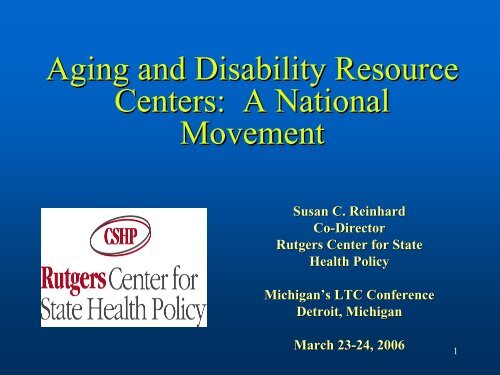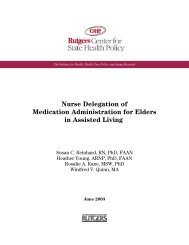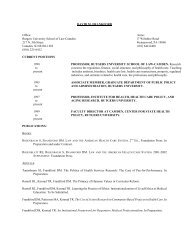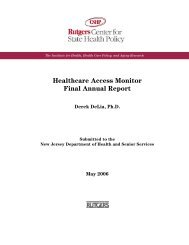6420 - Center for State Health Policy, Rutgers University
6420 - Center for State Health Policy, Rutgers University
6420 - Center for State Health Policy, Rutgers University
Create successful ePaper yourself
Turn your PDF publications into a flip-book with our unique Google optimized e-Paper software.
Aging and Disability Resource<br />
<strong>Center</strong>s: A National<br />
Movement<br />
Susan C. Reinhard<br />
Co-Director<br />
<strong>Rutgers</strong> <strong>Center</strong> <strong>for</strong> <strong>State</strong><br />
<strong>Health</strong> <strong>Policy</strong><br />
Michigan’s LTC Conference<br />
Detroit, Michigan<br />
March 23-24, 24, 2006<br />
1
Goals<br />
• Highlight key developments in the<br />
Aging and Disability Resource <strong>Center</strong><br />
movement across the country.<br />
• Offer state examples of best<br />
practices.<br />
• Learn from Michigan.<br />
2
Key Building Blocks<br />
PERSON<br />
Philosophy of self-direction and<br />
individual control in legislation,<br />
policies, and practices<br />
Coherent Systems<br />
Management<br />
Access<br />
Comprehensive in<strong>for</strong>mation,<br />
simplified eligibility, and<br />
single access points<br />
Financing<br />
A seamless funding system<br />
supporting individual choice<br />
Services<br />
Responsive supports across<br />
settings and provider types<br />
Quality Improvement<br />
Comprehensive systems<br />
that assure quality of life<br />
and services<br />
Community<br />
Life<br />
3
Change…Around the Country<br />
• AOA and CMS<br />
historic<br />
collaboration<br />
• 43 ADRC grantees<br />
to date<br />
4
What is the ADRC Initiative?<br />
• An HHS initiative jointly developed and<br />
administered by the Administration on Aging<br />
(AOA) and the <strong>Center</strong>s <strong>for</strong> Medicare & Medicaid<br />
Services (CMS).<br />
• 1 st Partnership of this significance between CMS<br />
and AoA.<br />
• Develop a national framework <strong>for</strong> a single point of<br />
entry system in states.<br />
• Awards to state agencies coupled with a National<br />
Technical Assistance Program led by Lewin and<br />
includes <strong>Rutgers</strong> CSHP.<br />
5
Aging and Disability<br />
Resource <strong>Center</strong> Vision<br />
Create a single, coordinated system<br />
of in<strong>for</strong>mation and access <strong>for</strong> all<br />
persons seeking long-term support<br />
to minimize confusion, enhance<br />
individual choice, and support<br />
in<strong>for</strong>med decision-making.<br />
6
Why a Single Point of Entry?<br />
• Long-term care system in many states is<br />
fragmented and disjointed with many public and<br />
private programs and services delivered by a<br />
variety of agencies and organizations.<br />
• Navigating the long-term care system can be<br />
confusing and frustrating <strong>for</strong> persons with<br />
disabilities of all ages and their family members.<br />
• Many may be placed in an institutional facility<br />
because they and their family members were<br />
unaware of, or could not easily access, home and<br />
community-based long term care services.<br />
7
Key Questions <strong>for</strong> <strong>State</strong>s<br />
• What is “entry”?<br />
• A system that enables consumers to<br />
access long-term and supportive<br />
services through one agency or<br />
organization?<br />
• 42 CEPs in 32 states and DC.<br />
• Different functions per<strong>for</strong>med.<br />
8
Potential Functions of a Single<br />
Entry Point<br />
• In<strong>for</strong>mation &<br />
referral<br />
• Assistance<br />
• Web based I&A<br />
• Initial screening<br />
• NF preadmission<br />
screening<br />
• Assessment<br />
• Financial eligibility<br />
• Functional<br />
eligibility<br />
• Develop care plan<br />
• Authorize service<br />
• Monitor services<br />
• Reassessment<br />
• Protective services<br />
9
ADRC Role<br />
• Provide in<strong>for</strong>mation and assistance<br />
to public and private-pay individuals.<br />
• “Entry” point to publicly<br />
administered long-term supports.<br />
• Target individuals at imminent risk of<br />
admission to an institution by<br />
creating linkages with the pathways<br />
to long-term care.<br />
10
Goals & Functions of an ADRC<br />
Awareness & In<strong>for</strong>mation<br />
• Public Education<br />
• In<strong>for</strong>mation on Options<br />
ACCESS<br />
Assistance<br />
• Options Counseling<br />
• Benefits Counseling<br />
• Employment Options Counseling<br />
• Referral<br />
• Crisis Intervention<br />
• Planning <strong>for</strong> Future Needs<br />
Access<br />
AWARENESS<br />
&<br />
INFORMATION<br />
CONSUMER<br />
ASSISTANCE<br />
• Eligibility Screening<br />
• Private Pay Services<br />
• Comprehensive Assessment<br />
• Programmatic Elig. Determination<br />
• Medicaid Financial Elig. Determination<br />
• 1-Stop Access to all Public Programs<br />
11
2003 ADRC Grantees<br />
• 12 <strong>State</strong>s (first year):<br />
Louisiana<br />
Maine<br />
Maryland<br />
Massachusetts<br />
Minnesota<br />
Montana<br />
New Hampshire<br />
New Jersey<br />
Pennsylvania<br />
Rhode Island<br />
South Carolina<br />
West Virginia<br />
• 3-year cooperative agreement,<br />
sustainability<br />
12
• 12 grantees:<br />
2004 ADRC Grantees<br />
Alaska<br />
Arkansas<br />
Cali<strong>for</strong>nia<br />
CNMI<br />
Florida<br />
Georgia<br />
Illinois<br />
Indiana<br />
Iowa<br />
New Mexico<br />
North Carolina<br />
Wisconsin<br />
• 3-year cooperative agreement,<br />
sustainability<br />
13
• 19 grantees:<br />
2005 ADRC Grantees<br />
Alabama<br />
Arizona<br />
Colorado<br />
DC<br />
Guam<br />
Hawaii<br />
Idaho<br />
Kansas<br />
Kentucky<br />
Michigan<br />
Mississippi<br />
Nevada<br />
Ohio<br />
Tennessee<br />
Texas<br />
Vermont<br />
Virginia<br />
Washington<br />
Wyoming<br />
14
Activities of Pilot Sites<br />
• In<strong>for</strong>mation and Referral/Assistance.<br />
• Integrated Management In<strong>for</strong>mation<br />
Systems.<br />
• Public Education and Awareness:<br />
– Public websites.<br />
– Public web-based searchable resource<br />
databases.<br />
15
Activities of Pilot Sites<br />
• Streamlining Functional and Financial<br />
Eligibility:<br />
– Coordination with Medicaid eligibility staff on<br />
diversion ef<strong>for</strong>ts.<br />
– Electronic Medicaid applications.<br />
– Series of technical assistance briefs by<br />
<strong>Rutgers</strong>/NASHP (Reinhard/Mollica).<br />
• Marketing and Outreach to Target<br />
Populations.<br />
• Critical Pathway Interventions:<br />
– Outreach to hospitals and nursing homes to<br />
divert/transition consumers from institutions.<br />
16
Early Results<br />
• 43 grantees:<br />
– 12 in 2003; 12 in 2004; 19 in 2005.<br />
• 66 pilot sites opened between 2003 and<br />
2004 grantees.<br />
• 12 grantees serve people with all types of<br />
disability:<br />
– 7 serving people with disabilities of all ages.<br />
– 5 serving all adults with disabilities.<br />
• 31 grantees serve all older adults and<br />
select groups of people with disabilities.<br />
17
Early Results<br />
• 8 of 43 grantees will have state/territorywide<br />
service areas by Year 3:<br />
– AK, AZ, DC, IA, NH, NM, CNMI, RI.<br />
• 24 ADRC projects funded in 2003 and 2004<br />
developed over 250 unique partnerships.<br />
• 50% of 2003 and 2004 grantees have<br />
MOUs/MOAs with aging networks,<br />
disability networks and Medicaid.<br />
• 70% of 43 grantees planning MOUs/MOAs.<br />
18
Example: NJ Aging & Disability<br />
Resource Connection (ADRC)<br />
• Builds on NJEASE (1996 SPE).<br />
• Among first 12 states to get ADRC funding.<br />
• Department of <strong>Health</strong> and Senior Services is lead agency with<br />
Department of Human Services as partner.<br />
• Redesign aging and disability service systems: multiple entry<br />
points that are coordinated and standardized.<br />
• 2 pilot sites at county level: Atlantic (urban) and Warren<br />
(rural).<br />
• Major component HCBS/CMS Quality Model & Consumer<br />
Satisfaction.<br />
19
New Jersey’s Three-Pronged Strategy<br />
<strong>for</strong> Systems Change<br />
• Consolidation at state level.<br />
• Create more choices <strong>for</strong> HCBS services.<br />
• Help consumers find choices through<br />
NJEASE and Community Choice<br />
Counseling.<br />
20
ADRC Target Populations<br />
• Year 1:<br />
– 60 and older.<br />
• Years 2 and 3:<br />
– 60 and older;<br />
– Adults with physical disabilities.<br />
• Special focus on hard-to-serve and<br />
underserved populations.<br />
21
NJ ADRC Goals<br />
• Bring Aging and Disability together.<br />
• Improve pathways to obtain in<strong>for</strong>mation,<br />
determine financial and functional<br />
eligibility, and receive services.<br />
• Build on NJ EASE as visible, responsive,<br />
and trusted sole source <strong>for</strong> home and<br />
community-based services available<br />
24/7/365.<br />
22
Community Choice Counseling<br />
• One of largest nursing home<br />
transition programs in the<br />
nation.<br />
• <strong>State</strong> staff members crosstrained<br />
to do Pre-admission<br />
screening, options counseling,<br />
and transition support.<br />
23
CCC Integration<br />
24
NJ ADRC Organizational Components<br />
• <strong>State</strong> Management Team:<br />
– Senior leadership;<br />
– Leadership <strong>for</strong> System Design.<br />
• ADRC Advisory Board:<br />
– 50% consumers, 50% professionals.<br />
– 12 reps from aging network, 12 reps from<br />
disability networks.<br />
• System Design Workgroups:<br />
– 212 participants, 90 meetings.<br />
• Atlantic County Pilot Site.<br />
• Warren County Pilot Site.<br />
25
Atlantic County Pilot Site:<br />
The Focus<br />
• Interface with disability network.<br />
• Implement NJ 211.<br />
• Enhance current I&A operation.<br />
• AIRS/CIRS certification <strong>for</strong> all partners.<br />
• Develop and test cultural competency<br />
model.<br />
26
Warren County Pilot Site:<br />
The Focus<br />
• Test in-depth assessment process.<br />
• Develop interdisciplinary assessment<br />
teams.<br />
• Create policies/protocols <strong>for</strong> in-depth<br />
assessments <strong>for</strong> state and federally<br />
funded aging and disability LTC programs.<br />
• Implement consumer direction.<br />
• Develop protocols <strong>for</strong> finalizing and<br />
authorizing publicly-funded services.<br />
• Enhance care management between aging<br />
and disability networks.<br />
27
ADRC Highlights/Activities<br />
• ADRC consolidated application based on:<br />
– Fast-track determination.<br />
– Simplified Medicaid application.<br />
• Atlantic County pilot designated NJ 211.<br />
• Work with DHS to determine if ADRC could use<br />
same benefits screening application DHS is<br />
using <strong>for</strong> its programs.<br />
28
ADRC Highlights/Activities<br />
• Definition of cultural competency approved.<br />
– Will serve as guide <strong>for</strong> training curriculum<br />
development.<br />
• Public awareness campaign:<br />
– Surveys sent to service providers statewide;<br />
– 6 focus groups in Atlantic County to learn about<br />
how residents hear about ADRC services, their<br />
needs and priorities.<br />
29
Lessons Learned<br />
• Interdependency between Medicaid and<br />
aging and disability networks.<br />
• Communications and face-to-face<br />
dialogue with stakeholders (AAAs, LTC<br />
providers) are key.<br />
• Message control and revision need to be<br />
on-going during ADRC implementation.<br />
30
Example: Wisconsin’s<br />
Aging and Disability<br />
Resource <strong>Center</strong>s<br />
• 3-year FY04 grant of $800,000.<br />
• Lead agency: Wisconsin Department of<br />
<strong>Health</strong> and Family Services.<br />
• Expand geographic coverage of fullservice<br />
ADRCs.<br />
• Develop capacity <strong>for</strong> all target groups.<br />
• Develop infrastructure to support<br />
statewide expansion.<br />
31
WI ADRC Goals/Activities<br />
• Develop state-level infrastructure to support<br />
current and future development of statewide<br />
ADRC system.<br />
– 2 toolkits: one <strong>for</strong> public awareness; one <strong>for</strong> LTC options<br />
counseling.<br />
– Identify and implement in<strong>for</strong>mation management system solutions<br />
<strong>for</strong> consistent state and local data collection and reporting.<br />
• Merge department responsible <strong>for</strong> Medicaid<br />
financial eligibility (<strong>for</strong>merly Department of<br />
Work<strong>for</strong>ce Development) with Department of<br />
<strong>Health</strong> and Family Services.<br />
• Develop MOUs with financial eligibility units to<br />
establish roles of ADRC in coordinating financial<br />
eligibility process.<br />
32
WI ADRC Goals/Activities<br />
• <strong>State</strong>wide web-based resource database.<br />
• Integration of functional screen with financial<br />
eligibility database and I&A data.<br />
• Functional screen web development <strong>for</strong><br />
children and people with mental health<br />
issues.<br />
• Greater collaboration between county<br />
agencies and community resources.<br />
33
WI ADRC Target Populations<br />
• Year I:<br />
– 60 and older;<br />
– At least one other target group (adults with physical<br />
disabilities or developmental disabilities.<br />
• Year II:<br />
– 60 and older;<br />
– Adults with physical disabilities and/or developmental<br />
disabilities.<br />
• Year III:<br />
– 60 and older;<br />
– Adults with physical and/or developmental disabilities;<br />
– Adults with mental health needs.<br />
34
Wisconsin Pilot Sites<br />
• 5 Resource <strong>Center</strong><br />
and CMO pilots.<br />
• 4 Resource <strong>Center</strong><br />
only pilots.<br />
35
Wisconsin’s Family Care Program<br />
• A redesign of WI’s LTC system.<br />
• Gives people better choices about where<br />
to live and what services/supports to<br />
receive.<br />
• Improves access to services.<br />
• Improves quality through focus on<br />
health and social outcomes.<br />
• Creates a cost-effective system.<br />
36
Family Care Organizational<br />
• Resource <strong>Center</strong>s.<br />
Components<br />
• Care Management Organizations.<br />
• Governing Boards.<br />
• Department of <strong>Health</strong> and Family Services.<br />
• <strong>State</strong> LTC Council.<br />
• Local LTC Councils.<br />
• Independent Enrollment Consultant.<br />
• Economic Support Units.<br />
37
Service Delivery Structure<br />
Resource <strong>Center</strong> (RC)<br />
• Outreach<br />
• In<strong>for</strong>mation and Assistance<br />
• Family Care Functional Eligibility Determination<br />
• LTC Options and Benefit Counseling<br />
• Pre-admission Consultation<br />
Independent Enrollment Consultant (EC)<br />
• Review Options<br />
• Report Choice on CMO and RC<br />
Economic Support Unit (ESU)<br />
• Financial Eligibility and Recertification<br />
• Records of Level of Care and Enrollment<br />
Case Management<br />
Organization (CMO)<br />
• Care Management<br />
• Individualized Service Plans<br />
(ISP)<br />
• Arrange <strong>for</strong> Direct<br />
Services<br />
• Reassessments <strong>for</strong><br />
Some Counties<br />
• Provider Networks/Payment<br />
• Facilitate Consumer<br />
Directed Option<br />
• Claims processing and<br />
record keeping<br />
• Quality<br />
Assurance/Improvement<br />
• Compliant and Grievance<br />
Resolution<br />
38
Origins of Resource <strong>Center</strong>s<br />
• Three are from county Departments on Aging.<br />
• One is from the county Public <strong>Health</strong><br />
Department and the Department on Aging.<br />
• Four is from county Social Service or Human<br />
Service agencies.<br />
• One is split between the Aging Program and<br />
the Developmental Disabilities Program, both<br />
in the county Human Services Department.<br />
39
Lessons Learned<br />
• Importance of joint strategic planning, shared vision,<br />
interaction, and collaboration among local county<br />
departments and agencies involved with LTC.<br />
– Put people first.<br />
– Give up organizational turf.<br />
• Local aging agencies are naturals to develop ADRCs because<br />
of their experience with diverse populations and broad<br />
mission.<br />
– Broadening knowledge of disability resources and issues<br />
strengthens agency as a whole and enhances services to older<br />
adults.<br />
– Target groups have more in common than originally thought.<br />
• Local human service/social service departments bring own<br />
strengths:<br />
– Existing intake system;<br />
– Some separation between ADRC and rest of county department<br />
may reach more people.<br />
40
Lessons Learned<br />
• Communication and collaboration between all local entities<br />
involved in eligibility is vital to make the process work <strong>for</strong><br />
consumers.<br />
– Having written access plans or MOUs between local entities is<br />
helpful in having common ground to refer back to.<br />
• Outreach and marketing needs to be ongoing.<br />
– Involves all kinds of staff: administrative, nursing, and social<br />
work.<br />
• Developing, paying <strong>for</strong>, and continuing to support<br />
in<strong>for</strong>mation systems necessary <strong>for</strong> I&A is challenging:<br />
– Allot ample time to keep resource database updated.<br />
– Partner with United Way First Call <strong>for</strong> Help <strong>for</strong> assistance in<br />
updating.<br />
– Pre-existing software packages to establish database may be<br />
useful.<br />
41
Lessons Learned<br />
• Prevention activities are useful tools<br />
<strong>for</strong> marketing and outreach.<br />
• Short-term case management is a<br />
natural component of I&A.<br />
– Private-pay and publicly-funded people<br />
have same short-term needs.<br />
– Maintain list of people who provide<br />
chore services to increase access to<br />
services <strong>for</strong> private-pay LTC<br />
consumers.<br />
42
Lessons Learned<br />
• It takes at least a year to fully train I&A specialist.<br />
– Mentoring and shadowing experienced staff very effective<br />
training tool.<br />
• What to look <strong>for</strong> in I&A staff:<br />
– Ability to communicate effectively in person or on the<br />
phone.<br />
– Interviewing and listening skills.<br />
– Ability to focus on consumer’s agenda, not staff’s.<br />
– Good observational skills.<br />
– Ready to offer short-term services.<br />
– Experience/background with target population.<br />
– Knowledge of how service system works.<br />
43
• 3-year FY05 grant of $800,000.<br />
Example: Washington<br />
Aging and Disability<br />
Resource <strong>Center</strong><br />
• Lead agency: Washington Department of Social and<br />
<strong>Health</strong> Services, Aging and Disability Services<br />
Administration.<br />
• Expand capabilities of I&R/A system to serve people of<br />
all ages, disabilities, and financial circumstances.<br />
• Connect seamlessly to relevant home and communitybased<br />
services and supports.<br />
44
Split SEP System in Washington<br />
• <strong>State</strong> agency staff completes all<br />
assessments.<br />
• Determines clinical and financial<br />
eligibility.<br />
• Reviews service options.<br />
• Develops initial care plan.<br />
• Provides CM <strong>for</strong> consumers in nursing<br />
homes and residential settings.<br />
• AAAs provide ongoing CM <strong>for</strong> in-home<br />
clients.<br />
45
WA ADRC Goals/Activities<br />
• Build partnerships with other state-level<br />
agencies, independent living centers,<br />
211, and other associations.<br />
• Employ technology <strong>for</strong> seamless ADRC<br />
one-stop operations.<br />
• Expand CARE system to assess<br />
individuals <strong>for</strong> non-Medicaid funded<br />
programs.<br />
46
WA ADRC Goals/Activities<br />
• Use social marketing strategies to<br />
actively promote public awareness of<br />
both public and private long-term<br />
support options and the Resource<br />
<strong>Center</strong>.<br />
• Improve connections with NAPIS<br />
reporting system and Benefits Check Up.<br />
47
WA ADRC Target Populations<br />
• Year 1:<br />
– 60 and older;<br />
– Adults with functional disabilities.<br />
• Years 2 and 3:<br />
– 60 and older;<br />
– Adults with functional disabilities;<br />
– People of all ages with developmental<br />
disabilities.<br />
48
Overview of ADRC Challenges<br />
• Leadership<br />
– Bringing Aging and Disability together<br />
– <strong>State</strong> and Local Agencies<br />
• System Design<br />
• Coordination & Data<br />
• Personnel & Staffing<br />
• Outreach & Promotion<br />
• Funding and Sustainability<br />
49
• Who Will Push Re<strong>for</strong>m?<br />
– Need to bring Aging and Disability Communities<br />
together<br />
• <strong>State</strong> Agencies<br />
– Aging agency<br />
– Medicaid agency<br />
Leadership<br />
– Disability agencies (multiple in many cases)<br />
• Will Local Agencies Embrace Change?<br />
– Build local coalitions to establish community buy-in<br />
50
System Design<br />
• Vision and Mission should lead design.<br />
• Scope?<br />
– Employment counseling?<br />
– <strong>Health</strong> promotion?<br />
– Food stamps?<br />
– Housing?<br />
– Nursing home transition?<br />
• Key issues include:<br />
– Functional needs assessment, instruments.<br />
– Financial eligibility determinations.<br />
51
Coordination and Data<br />
• Growing need <strong>for</strong> more data:<br />
– Functional and financial.<br />
– Tracking and monitoring at individual and<br />
aggregate levels.<br />
• IT and MIS:<br />
– Unifying <strong>for</strong>ms and data across agencies.<br />
– Data sharing across agencies and stakeholders.<br />
– In<strong>for</strong>mation, referral, eligibility and care<br />
management software.<br />
52
Personnel & Staffing<br />
• Budget challenges.<br />
• Skill mix (credentials, unions).<br />
• Cross Training (aging and<br />
disability,cultural competence, programs).<br />
53
Outreach & Promotion<br />
• Reaching all older adults regardless of<br />
income.<br />
• Reaching persons with disabilities.<br />
• Social marketing.<br />
• Capacity in relation to outreach.<br />
54
Funding and Sustainability<br />
• Business model:<br />
– Increasing Service Demand as visibility<br />
increases.<br />
– Unfamiliar funding streams--private pay<br />
and Medicaid in addition to OAA.<br />
• How much public funding needed??<br />
– Political Support.<br />
– Details on matching funds.<br />
55
Susan C. Reinhard<br />
Co-Director<br />
<strong>Rutgers</strong> <strong>Center</strong> <strong>for</strong> <strong>State</strong> <strong>Health</strong> <strong>Policy</strong><br />
Director<br />
Community Living Exchange at <strong>Rutgers</strong><br />
Technical Assistance <strong>for</strong> Real Systems<br />
Change<br />
732-932<br />
932-4649<br />
sreinhard@ifh.rutgers.edu<br />
56





